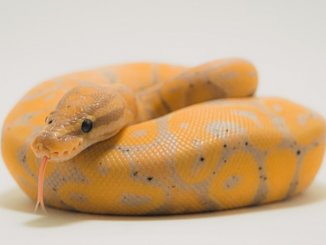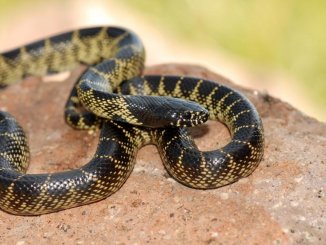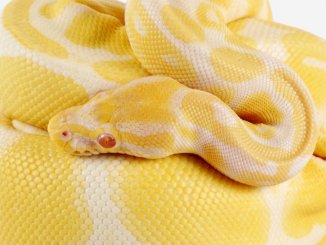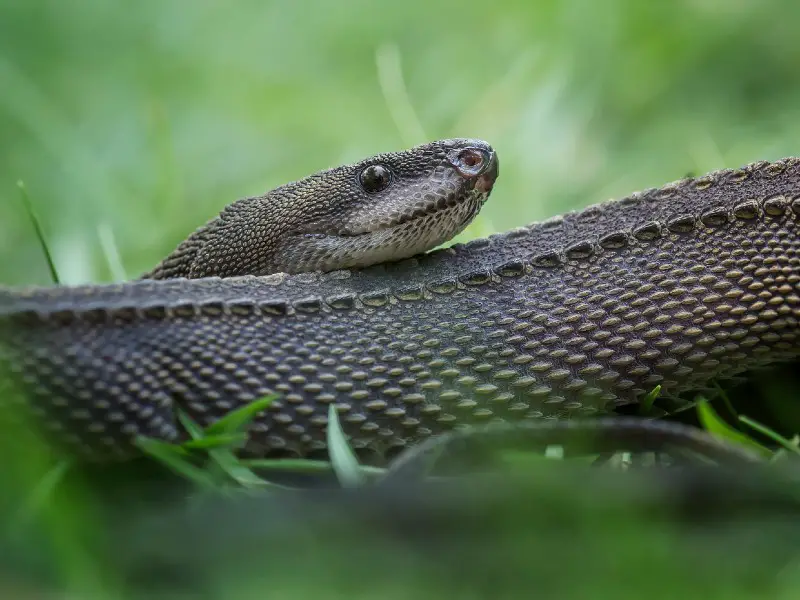
The dragon snake belongs to the family Xenodermus. While it is a rather shy and harmless snake, many individuals fear this fine specimen because of the way it looks.
It is also known by several other names in different locations. For instance, some people call it the Javan tubercle snake, or rough-backed litter snake.
The dragon snake is a rare snake that most people don’t keep because it doesn’t do well in captivity. As you might have guessed from its name, the dragon snake has marked features of a dragon.
It is a nocturnal snake that feeds mainly on frogs, which is probably why it stays on the forest floor.
The dragon snake, not being much of an active breeder, lays about four eggs per year. It is native to Thailand, Indonesia, and Burma, where it can be found in the deep forests.
Overview
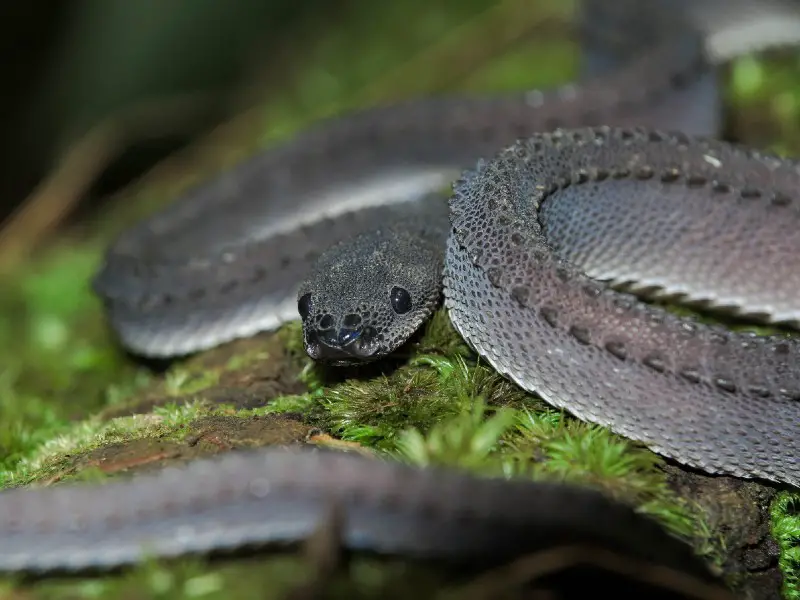
Most people consider the dragon snake to be the holy grail of obscure reptile species. However, there is a great amount of misinformation on the species.
As a result, most people choose not to keep them. However, contrary to the belief that dragon snakes are impossible to keep, many successful breeders have managed to crack the code as far as dragon snake care goes.
The dragon snake is a non-venomous colubrid snake mainly found in the higher altitude regions of Southeast Asia. It is a semi-fossorial species that spends the majority of its time underground.
These snakes usually go out at night to hunt. Because of their diet, which consists mainly of small frogs and fish, you are most likely going to find dragon snakes in areas near water or streams.
The dragon snake can grow to reach approximately 24-30 inches in length. Because it tends not to thrive in captivity, this snake is quite rare in the pet trade.
It is a high-maintenance species that requires very stringent conditions to thrive. Another thing that makes this snake not so popular is how it doesn’t take kindly to excessive handling.
While it won’t usually bite when handled, the snake will rather go stiff.
This might not sound so threatening, at least not to the handler. However, repeated handling will stress the snake and cause it to start refusing to eat.
Despite how difficult it might seem to care for this snake, several people have successfully kept and bred them.
Care Guide
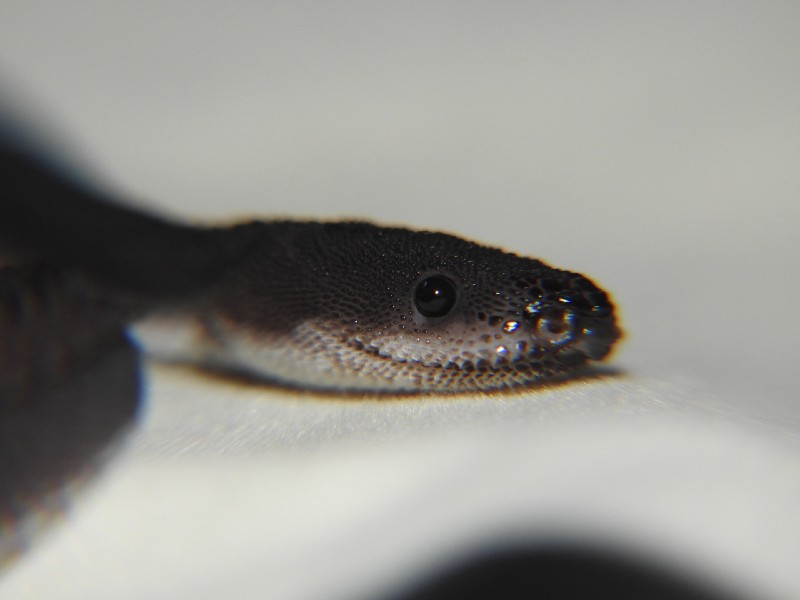
Because dragon snakes are not common pets, there are many gaps when it comes to their husbandry. This is the same situation with setting up their habitat within their enclosure.
One of the most important factors to consider when working with dragon snakes is the choice of substrate. For better results, it is advisable to pick a substrate like a sphagnum moss.
This is an ideal choice that retains moisture but won’t get too wet.
If there is a mold build-up on the substrate, there is a risk that the snake will fall seriously ill. Because dragon snakes are completely nocturnal, you will want to provide a safe, dark place for them to hide in during the day.
For this, you can take a look at the several reptile hides. These are usually made using plastic because it’s easy to clean and it stays mold-free.
Temperature & Lighting
This is where things start getting a bit unusual. Unlike most snakes, dragon snakes do not require a hot spot in their enclosures. This snake will not tolerate too much heat at all.
To achieve the best results, you must aim to keep the enclosure between 72 and 77 degrees Fahrenheit. This is unlike the required care practices of other pet snakes.
You will also benefit from keeping a reliable thermometer close by to measure the enclosure’s internal temperature. If the dragon snake is exposed to temperatures of more than 80 degrees for more than an hour, it will die.
Humidity
To keep your dragon snake happy and healthy, it is best to maintain a high humidity level within the enclosure. For your snake to thrive, it is advisable to keep a humidity level in the range of 85 to 95 percent.
This is a very high level of humidity. Therefore, you will need to set up a proper habitat to maintain it. That is also why you need to choose the correct substrate.
If you pick a perfect substrate, it will also contribute greatly to maintaining the required level of moisture needed to keep humidity levels consistent.
To prevent the enclosure from drying out, you can mist it a few times a day.
Water
You must always keep a consistent source of clean and fresh water in the dragon snake’s enclosure.
These snakes love drinking and soaking in water. As such, you must make sure you provide a water area big enough for the snake to curl up.
Some people use a plastic bowl. However, you can also make a water receptacle from stone.
Regardless of the material you choose, it is important to ensure that the water area is kept immaculately clean.
Take the bowl out for cleaning once a week and replace the water frequently. If the water stays in the bowl for too long, the snake will be exposed to bacteria and disease.
Feeding
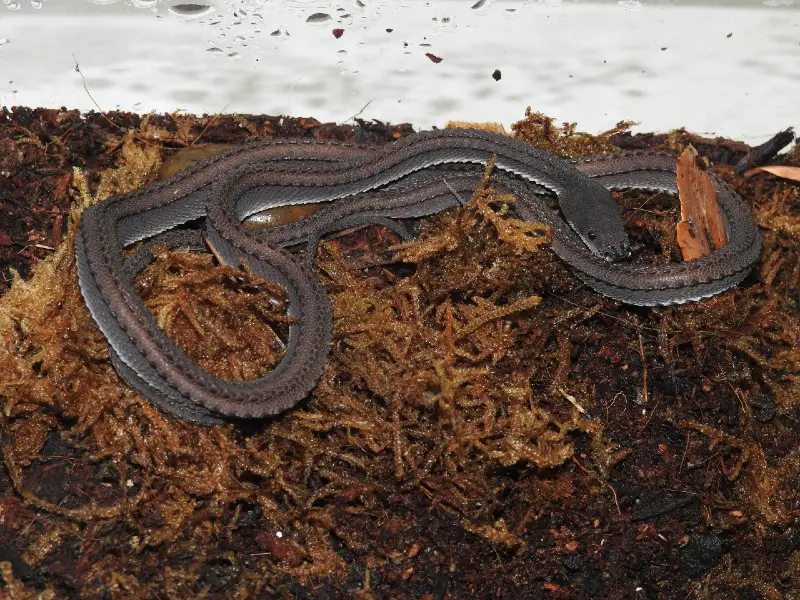
Once a dragon snake has settled well, feeding it will not be a challenge. When in their natural habitat, these snakes usually feed on tadpoles, frogs, and small fish.
Most people who keep dragon snakes feed them mosquito fish, treefrog tadpoles, and treefrog adults. These fish and frogs are available from various suppliers online. You can even check at your local fish store.
When feeding a smaller snake, it is advisable to give it medium to large-sized treefrog tadpoles. You can also give it small feeder fish.
Ideally, you must place three to five tadpoles or a single fish in the water bowl every five days.
It is also a good idea to keep the water bowl as shallow as possible, only allowing enough water for the fish and tadpoles to swim.
If the bowl is too deep, you risk having the fish jumping out.
When it comes to feeding fish, the dragon snakes aren’t selective. This means you can feed any species of fish.
However, you will want to avoid feeding fish that are high in thiaminase.
This enzyme breaks down thiamine, which the snake needs to metabolize to function and grow. Some of the species that are considered safe include mosquito fish, guppies, and platies.
These fish species have a relatively low thiaminase content.
You must note that adult tree frogs are a bit difficult for the snake to hunt. These frogs usually sit at the top of the enclosure, right where the lid meets the bin.
This makes it difficult for the dragon snake to eat this frog seeing as it prefers staying within the confines of its hide or even under the substrate.
Another important thing to note is that dragon snakes are voracious eaters. As such, you must limit how much they eat; otherwise, they will overheat and regurgitate.
Nevertheless, if you follow these general feeding guidelines, you will enjoy your dragon snake for a long time.
Lifespan & Health Concerns
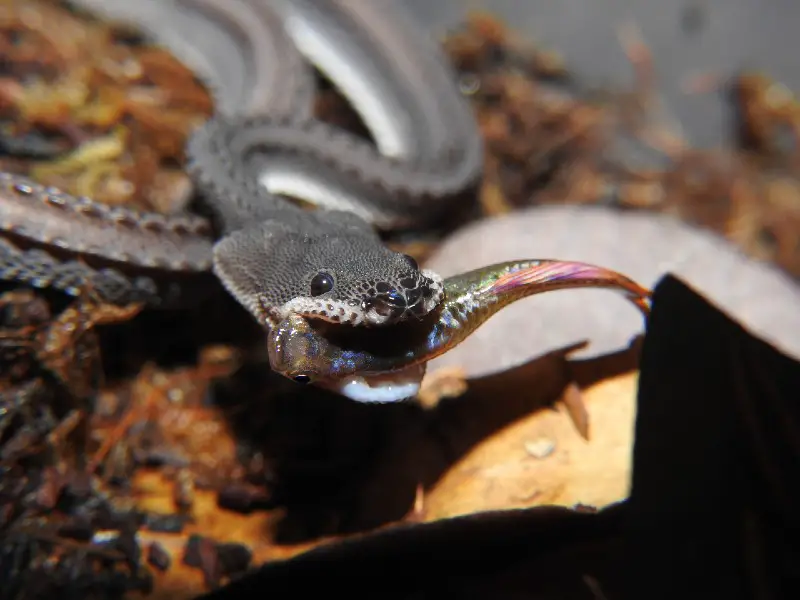
There are no clear facts about how long dragon snakes live in the wild. However, those who have experience managing them in captivity have taken care of them for as long as seven years at times.
The dragon snake has three basic life stages:
Hatchlings
Normally, the female dragon snake will lay only two to four eggs each year. After these eggs hatch, the hatchlings will stay hidden in the snake’s nest for a while. As they grow up, they will then start leaving the nest to hunt for food.
Juveniles
When the younger dragon snakes are a year old, they will start resembling the adult’s unique colors and features. These juvenile snakes have a huge appetite, and they stay on the forest floor, where they continuously hunt for prey.
Adults
Adult dragon snakes are nocturnal. They hunt and eat during the nighttime. They also remain on the forest floor, where they hunt for frogs, which are their favorite prey.
When it’s mating season, these snakes will start reproducing. The dragon snake’s eggs are laid during the rainy season, which spans from October to February.
Health Concerns
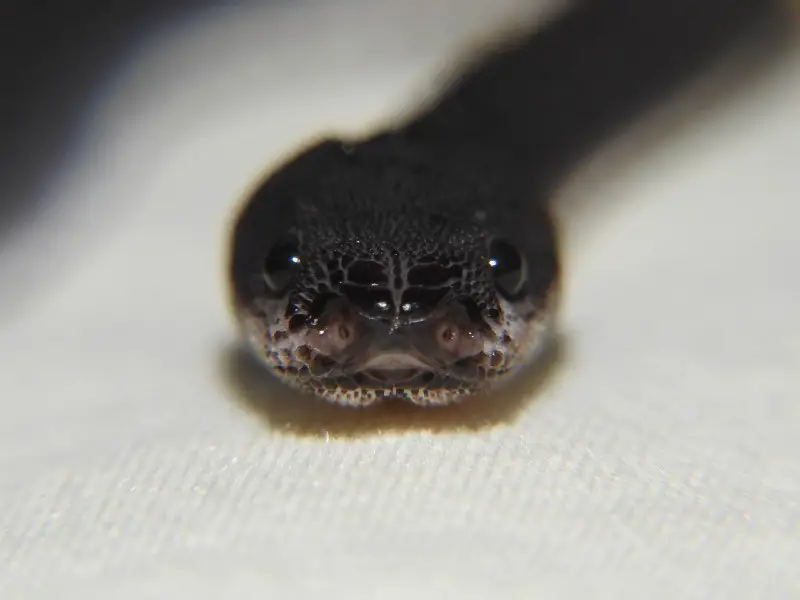
The most significant concern when it comes to dragon snake care is their potential parasite load. Therefore, it is important to ensure that all snakes are treated for internal parasites within seven days of acquiring them.
Fortunately, it is not difficult to detect external parasites on the snakes if they are present. External parasites are also relatively easy to treat. On the other hand, internal parasites can be quite problematic.
Many inexperienced keepers recommend taking the snakes to a veterinarian for an in-depth examination. However, you must make sure that the snakes are not too stressed when you take them to a veterinarian.
In some instances, putting them through too much stress can be a major cause of the decline and eventually death.
Dragon Snakes and Stress
Dragon snakes can’t handle stress very well. It is advisable to avoid stressing them at all costs. In addition, you must take time to research the common dragon snake problems so you don’t take them to the vet too frequently.
Therefore, it would be best if you learn to examine and identify potential issues with your dragon snake.
Apart from that, you must also ensure that you develop a very good relationship with your veterinarian so you can ask for tips on how to handle the snake and avoid stressing it.
Most experienced keepers are able to treat all snakes for parasites with the help of a veterinarian or via Telemedicine.
Learning this will allow you to handle the snake’s problems without having to put it through the stress of long drives and physical examination.
Common Health Problems
Research shows that dragon snakes are rather susceptible to skin irritations resulting from a moldy and unclean enclosure.
That’s why you need to keep a clean enclosure to maintain the snake’s long-term health. Other common problems include obesity and high sensitivity to heat.
Ensuring that your dragon snake stays in good health is mainly an issue of basic maintenance skills. You must learn to identify signs indicating that your snake is healthy, as well as those showing you that your snake is sick.
Your snake will most likely stay healthy as long as you feed it properly and maintain its cage regularly. When observing the snake for signs of illness, please note that a healthy snake will have beautiful clear eyes, nose, and mouth.
They are also alert and active. You should also know that healthy snakes feed regularly, and they have healthy skin and a nice round body.
There are several characteristics that might indicate that your snake is unwell. These are some of the signs that might indicate that your snake is not well:
- Wrinkles on the skin
- Lethargy
- Discharge from the nose or mouth
- Abnormal dropping
- Low appetite,
If you notice some of these signs and symptoms, you must contact your vet as soon as possible to find out what might be wrong with your pet.
These are some of the most common problems you might experience with dragon snakes:
- Constipation: lack of bowel movement for several days or weeks might be an indication that there is something wrong.
- Internal Parasites: these are common, especially if the dragon snake is from the wild. A snake with an internal parasite problem usually displays poor appetite, lack of energy, and overall tired appearance, and regurgitation.
- Regurgitation: This is usually a result of stress, overeating, or excessive handling. You should avoid handling your snake just after it has eaten.
- Skin Conditions: these are several skin conditions that affect dragon snakes. These include abscesses, blisters, cuts, and blisters. Apart from these conditions, dragon snakes can be affected by mites and ticks. If you notice any of these problems, consult your vet right away.
- Respiratory Conditions: the symptoms of respiratory conditions include lethargy, coughing, and open-mouth breathing wheezing.
Behavior
If you own or are planning to own a dragon snake, you must get to know its different behaviors, so you can provide better care for it. Here are some common behaviors of the dragon snake:
Can Keep Still Like Wood
When you pick this snake up, it might become as stiff as wood. They usually do this if they are nervous or afraid.
It is thought that this stiffening is one of the snake’s defense mechanisms. However, once the snake gets used to handling, it will overcome this fear.
Shy Snake
Dragon snakes are very shy. This can be overcome by regular handling. However, because these snakes are also easy to stress, you must not handle them excessively.
Sleeping Habits
Dragon snakes are nocturnal. Therefore, they usually do everything at night. Sometimes, the snake will only come out at night to feed and go back into hiding.
It is advisable to put your snake’s tank in a very quiet area so that it can rest during the day.
Water
Dragon snakes like drinking water from a dish. However, they can also lick it from foliage. It is crucial to add a water bowl to the snake’s enclosure to keep its habitat humid.
When there is adequate humidity, it will be easier for the snake to shed.
Temperament
Dragon snakes are not too aggressive. Their most common reaction is to stiffen up their bodies when they feel threatened by something.
Safety
Dragon snakes
are non-venomous; hence they are safe to handle. While they will bite sometimes, they don’t usually resort to aggression. However, it is advisable to be patient when handling the snake so that you don’t get bitten.
Price/Cost
A single dragon snake can be bought online for an average of $300. They are not too costly to keep. As long as you feed them properly, you won’t have to spend too much money maintaining them.
Facts
- Dragon snakes are non-venomous. While these snakes may appear scary, they are very shy, and they will simply stiffen up when threatened.
- Dragon snakes have an insatiable appetite; they feed on frogs, tadpoles, feeder fish,
- It’s not advisable to pick dragon snakes from the wild. Wild dragon snakes can have some dangerous parasites. Apart from that, there is a high chance that if you pick a dragon snake in the wild, it will not survive in captivity.
- Dragon snakes are native to southeast Asia. They are usually found in areas like Myanmar, Java, and Borneo.
- Dragon snakes are nocturnal. In the wild, they usually come out at night, and during the day, they prefer to stay underground.
- The skin of a dragon snake looks rough but will not hurt at all.
- Dragon snakes stiffen up when they feel threatened or frightened.
- Dragon snakes are rare, but they are not on the list of endangered snake species.
Summary
Dragon snakes are an interesting species that can be a bit difficult to keep.
For those interested in keeping snakes as pets, it is advisable to do a lot of research and learn how to handle them.
They are quite easy to stress, and once they are stressed, they might refuse to eat.
Their diet mainly consists of frogs and fish, and they must be kept in highly humid conditions.
Dragon snakes are also not very tolerant of heat. If they are kept in a hot environment, they will die.

